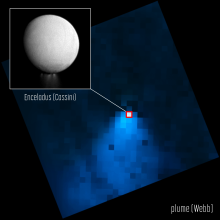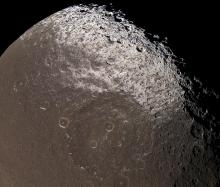Listen to today's episode of StarDate on the web the same day it airs in high-quality streaming audio without any extra ads or announcements. Choose a $8 one-month pass, or listen every day for a year for just $30.
You are here
Moon and Saturn
A big dust storm blanketed the planet Mars for much of this year, hiding much of the surface from view. And it turns out that Mars isn’t the only world besides Earth that has dust storms — so does Titan, the largest moon of Saturn.
Titan is the only moon in the solar system with a dense atmosphere. Clouds waft through the sky and produce rains that fill rivers and lakes. Titan is so cold, though, that the liquid isn’t water. Instead, it’s ethane and methane.
Titan also has large dune fields along its equator. The dunes are made up of grains of frozen hydrocarbons.
In 2009, the Cassini spacecraft saw some bright spots above the equator that were hundreds of miles long. They lasted from about half a day to several weeks.
Scientists originally thought the spots were patches of clouds. But a deeper analysis found that the spots weren’t the right composition or at the right altitude to be clouds. Instead, they probably were dust storms.
The storms required especially strong wind gusts — up to about 20 miles per hour. And they might have blown some of the dust far away from the equator — creating a light dusting across this intriguing moon.
And Saturn is near our own moon tonight. They’re quite low in the southwest at sunset, so there’s not much time to look for them. Saturn looks like a bright star close to the upper left of the Moon. If you miss them tonight, try again tomorrow night, when Saturn will stand to the lower right of the Moon.
Script by Damond Benningfield





